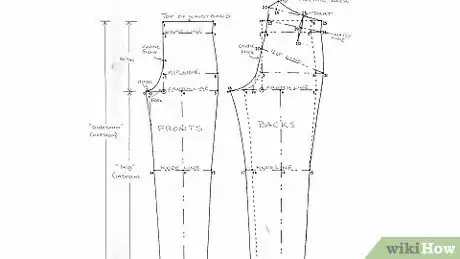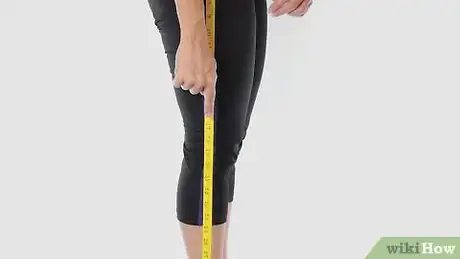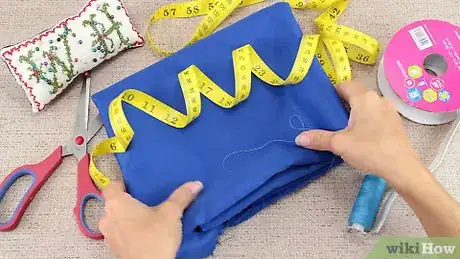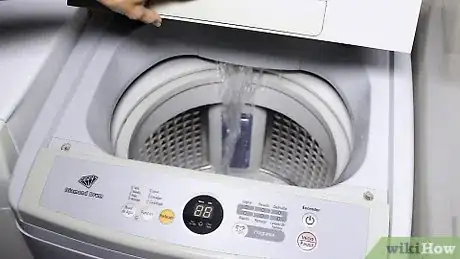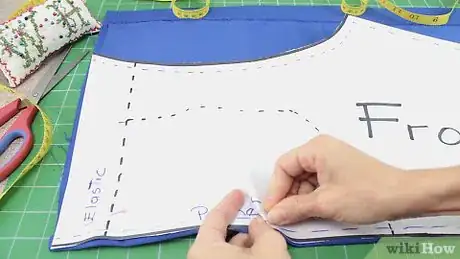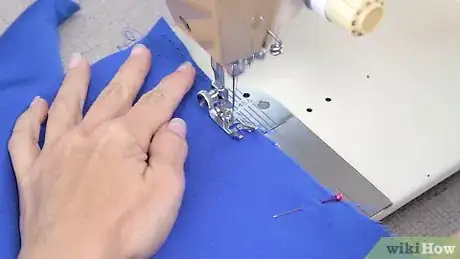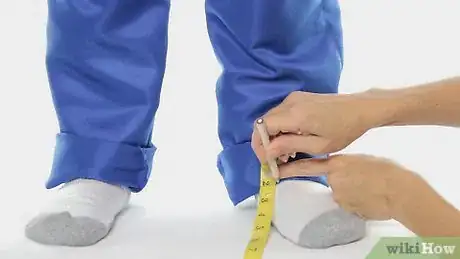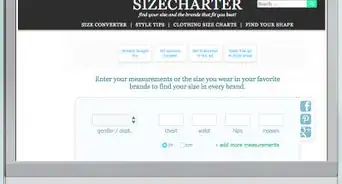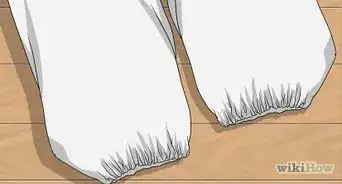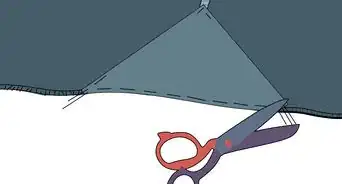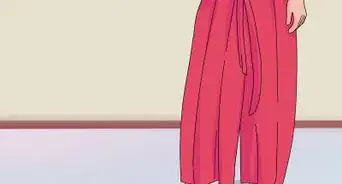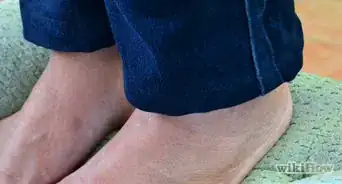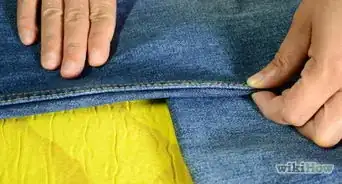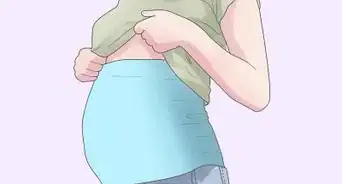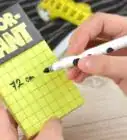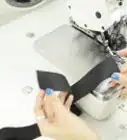This article was co-authored by Mia Danilowicz. Mia Danilowicz is a Master Tailor who works onset and on the red carpet in Los Angeles, California. With over a decade of experience, Mia specializes in bridal and gown couturier fittings, garment reconstruction, and custom design. Mia has worked at the Oscars, Grammys, SAG Awards, and Golden Globes. Her clients include a long list of entertainment and fashion industry headliners, major fashion magazines, luxury consumer brands, and popular media. Mia was trained at the Fashion Institute of Design and Merchandising and received her AA in Fashion Design and BS in Business Management.
There are 15 references cited in this article, which can be found at the bottom of the page.
This article has been viewed 507,855 times.
Trousers are a type of dress pant that men and women wear. They’re great for casual wear, or for a more formal look. You can make trousers using any type of fabric you like and in a variety of styles, from slim-fit to wide-leg. Select a pattern to guide you through making trousers and to ensure a good fit. Then, follow its instructions for how to cut, pin, and sew the pieces together into a stylish pair of trousers for yourself or for someone else.
Steps
Choosing Your Pattern and Fabric
-
1Choose a trouser pattern to guide your project. Making trousers requires sewing together accurately cut pieces of fabric. This is necessary to ensure that you get the style and size you want. Using a pattern will help you make trousers that look great and fit properly. Visit a craft supply store or look online for a trouser pattern that you want to use. Then, read the pattern carefully and follow its instructions to execute the design.[1]
- You don’t have to purchase a trouser pattern. There are many free patterns available online. Just search for “free trouser pattern” to find one.
- You can find trouser patterns in any style you like, such as slim-fit, wide-leg, bootcut, ankle-length, and more!
Tip: Patterns usually include details about the skill level needed to execute the design. If this is your first pair of trousers, you may want to go with an easy or beginner level pattern.
-
2Take 6 body measurements, if your pattern requires it. Some patterns are perfectly sized and others require you to measure and adjust before beginning. Once you get the hang of making trousers, you may want to move away from patterns and experiment by following these measurements. You may need to take the following measurements:[2]
- Outside leg. Using a fabric measuring tape, stretch it from the start of the waist over outside of the hip to the ankle.
- Inside leg. Measure the inside of the leg. Stretch your tape from the groin to the ankle.
- Hip. Measure the circumference of your hips from the widest point.
- Thigh. Measure the circumference at the widest point of your thigh.
- Ankle. Measure the circumference of your ankle, making sure you can get your feet through that measurement.
- Groin. Measure the distance from the waist band in front (around your navel) to the waistband in back, following the line of your groin.
Advertisement -
3Select a fabric that’s easy to sew for your first pair of trousers. Avoid slippery fabrics, such as silk and satin, stretchy fabrics, such as jersey or spandex, and fabrics that are hard to manipulate, such as faux leather and vinyl. Opt for something that’s easy to work with to make your first pair of trousers. Some good choices include:[3]
- Cotton
- Viscose
- Velour
- Canvas
- Linen
-
4Pre-wash the fabric to prevent it from shrinking later. This will help to ensure that your finished trousers won’t get distorted after the first time you wash them. Check to see what temperature, cycle, and drying method to use for the fabric you purchased.[4]
- For example, if you’re using cotton fabric, wash it on warm with like colors using a normal cycle, and then put it into the dryer on medium.
- If the fabric you’re using is delicate, then select the delicate setting on your machine and hang it up to air dry after it’s done.
Cutting and Pinning the Trousers
-
1Cut out the paper pattern pieces with a sharp pair of scissors. Refer to the pattern’s instructions if you are unsure what pieces you need. Patterns usually indicate the different sets of pieces required for a specific style with letters. Check to see what pattern letters you need and cut out these pieces.[5]
- Make sure to cut along the size lines that you want to make the trousers. For example, if you’re making a pair of US size 14 trousers, cut along these size lines.
- If you’re not sure what size you need for the pattern, take your measurements and look at the pattern’s size chart.
-
2Pin the paper pattern pieces to the fabric. Follow the pattern’s instructions for how to pin the paper pattern pieces to the fabric. You may need to fold the fabric before you pin the pattern pieces and line up the pattern against the folded edge of the fabric. Insert 1 pin every 2 to 3 in (5.1 to 7.6 cm) along the edges of the paper pattern pieces.[6]
- Make sure that the pins go through the paper and all layers of the fabric.
-
3Cut along the paper pattern pieces with a sharp pair of fabric scissors. Cut right along the edges, not outside or inside of them, to ensure that your pieces are the correct dimensions. Cut out 2 back pieces and 2 front leg pieces or 2 leg pieces along a fold as indicated by the pattern.[7]
- Go slowly to avoid creating any jagged edges in the fabric.
-
4Transfer dart and pleat markings to the back of the fabric. If there are darts or pleats on the edges of the pattern pieces, transfer the markings onto the underside of your fabric with a fabric marking pen or pencil. Do this just after you have cut the fabric, while the pattern is still on top.[8]
- Don’t cut along edges where the pattern instructs you to position the piece along a fold. These edges are meant to be kept intact.
Tip: Note that pre-packaged patterns include the seam allowance in the pieces. However, if you’re using an online pattern, it may not include the seam allowance. If this is the case, add 5⁄8 in (1.6 cm) all the way around the edges of each of the pieces before you cut. You can use a ruler and chalk to draw lines going around the outside of the pieces before you cut.[9]
-
5Pin the fabric pieces together according to the sewing instructions. Lay the pieces out and match up pieces that need to be sewn together. Place the pieces together so that their right sides are facing each other and their edges are aligned. Insert 1 pin every 2 to 3 in (5.1 to 7.6 cm) along each of the edges.[10]
- Ensure that each of the pins goes through both layers of fabric.
- Insert the pins so that they’re perpendicular to the edges of the paper pattern pieces. This will make it easier to remove them when you sew the pieces together.
Sewing the Trousers Together
-
1Attach the pockets before pinning the pantlegs together. Sewing pockets requires cutting out multiple pieces for each pocket and pinning them onto the edges of the pantlegs, then sewing, pressing, and topstitching the edges of the pockets. It’s not difficult to do, but it requires several additional steps and you’ll likely need to do this before sewing up the pantlegs and waistband of the trousers. Consult your pattern for details on how to add pockets to your pants.[11]
-
2Sew along the outer edge of each pantleg. Place the pinned edge of the pantleg under the presser foot of your sewing machine and sew a straight stitch down the edge. Keep the needle about 0.5 in (1.3 cm) from the raw edge of the fabric. This will provide plenty of security for the seam.[12]
- Remove the pins as you sew. Do not sew across the pins as this may damage your sewing machine.
- Make sure to use a thread that matches or complements your fabric. For example, if you’re making black trousers, you may choose to use black thread, or opt for yellow thread if you want it the thread to stand out.
Tip: Check your pattern for any special instructions about pressing seams and topstitching. You may need to unfold the pantlegs and topstitch them before proceeding to the next leg.
-
3Sew a straight stitch along the inseam of the pantleg. Repeat the straight stitch on the inseam of the trousers just as you did for the outside of the pantleg. Make sure to keep the stitch about 0.5 in (1.3 cm) from the raw edges of the fabric.[13]
- Remove the pins as you sew. Don’t sew over them.
-
4Insert 1 pantleg into the other and sew along the crotch. Turn 1 of the pantlegs right-side out and leave the other inside out. Insert the right-side out pantleg into the inside out pantleg so that the bottom edges of the pants are even and line up the crotch seams. Then, sew a straight stitch from the back of the pants across the crotch areas and around to the front. Position the stitch 0.5 in (1.3 cm) from the raw edges of the fabric.[14]
- If the fabric is slippery, you may want to insert pins through the edges of the fabric before you sew.
- If you’re adding a zipper to the front of the pants, leave the required amount of space for the zipper open on the front of the pants.
- If you’re using elastic to secure the pants, sew all the way up to the top edge of the waistband in the front of the pants.
-
5Install a zipper or elastic waistband to secure the pants. You can secure trousers with a zipper or an elastic waistband depending on what you prefer. Install the zipper in the opening you left in the front of the pants, or make a casing with the top edge of the pants and insert elastic through it.[15]
- Consult your pattern for details on what type of closure to use for the pants.
- For an extra sleek pair of trousers, try adding an invisible zipper.
-
6Trim and hem the pantlegs to the desired length. If you’re making the trousers for yourself, try them on and check the length. Have a friend help you with this part since you’ll need someone to pin the pants up to the desired length while you’re standing up straight. Or, if you’re making the pants for someone else, have them try them on and pin them up to the length they want. Then, remove the pants, trim the excess fabric, if needed, and sew across the folded edges of the pants to secure the hems.[16]
- Position the stitch about 0.5 in (1.3 cm) from the folded edges of the pantlegs.
- Make sure that the raw edges of the pantlegs are tucked up inside of the pantlegs and not visible.
- After you finish hemming the pantlegs, trim any remaining excess threads.
Expert Q&A
-
QuestionWhat's the best fabric to use?
 Mia DanilowiczMia Danilowicz is a Master Tailor who works onset and on the red carpet in Los Angeles, California. With over a decade of experience, Mia specializes in bridal and gown couturier fittings, garment reconstruction, and custom design. Mia has worked at the Oscars, Grammys, SAG Awards, and Golden Globes. Her clients include a long list of entertainment and fashion industry headliners, major fashion magazines, luxury consumer brands, and popular media. Mia was trained at the Fashion Institute of Design and Merchandising and received her AA in Fashion Design and BS in Business Management.
Mia DanilowiczMia Danilowicz is a Master Tailor who works onset and on the red carpet in Los Angeles, California. With over a decade of experience, Mia specializes in bridal and gown couturier fittings, garment reconstruction, and custom design. Mia has worked at the Oscars, Grammys, SAG Awards, and Golden Globes. Her clients include a long list of entertainment and fashion industry headliners, major fashion magazines, luxury consumer brands, and popular media. Mia was trained at the Fashion Institute of Design and Merchandising and received her AA in Fashion Design and BS in Business Management.
Master Tailor The best materials are woven. Many designs today have added 1-2% spandex into the fabric for comfort when wearing. Wool, cotton, natural fiber blends (e.g. silk, cashmere, and silk and wool blend), and polyesters are all suitable fabrics to make pants with.
The best materials are woven. Many designs today have added 1-2% spandex into the fabric for comfort when wearing. Wool, cotton, natural fiber blends (e.g. silk, cashmere, and silk and wool blend), and polyesters are all suitable fabrics to make pants with. -
QuestionHow can I use my measurements to determine the best sewing pattern?
 T. ChinsenTop AnswererYour best guide is to find a style that fits well and is comfortable, then look up the chart for that pattern. Take advantage of the measurement guide on a sewing pattern. The pattern books can be confusing, so ask in the fabric stores. If you are not an experienced stitcher, there are budget patterns like See & Sew. They provide straightforward instructions that make for a good sewing experience.
T. ChinsenTop AnswererYour best guide is to find a style that fits well and is comfortable, then look up the chart for that pattern. Take advantage of the measurement guide on a sewing pattern. The pattern books can be confusing, so ask in the fabric stores. If you are not an experienced stitcher, there are budget patterns like See & Sew. They provide straightforward instructions that make for a good sewing experience. -
QuestionDo I add some allowance while cutting the back, or are back and front equal?
 T. ChinsenTop AnswererFor loose-fitting pants, both front and back can be the same. Anything with shaping usually has 2" / 5 cm added allowance for the back piece. Look at your clothes that already fit and use them as a template if you want a specific style or fit.
T. ChinsenTop AnswererFor loose-fitting pants, both front and back can be the same. Anything with shaping usually has 2" / 5 cm added allowance for the back piece. Look at your clothes that already fit and use them as a template if you want a specific style or fit.
Things You’ll Need
- Trouser pattern
- Fabric
- Pins
- Scissors
- Chalk
- Thread
- Sewing machine
References
- ↑ https://www.superprof.co.uk/blog/sewing-trousers/
- ↑ https://www.moderntailor.com/static/mt/men_pants_measureguide.pdf
- ↑ https://www.superprof.co.uk/blog/sewing-trousers/
- ↑ https://www.youtube.com/watch?v=OGlgW5-oF5I&feature=youtu.be&t=50
- ↑ https://www.youtube.com/watch?v=OGlgW5-oF5I&feature=youtu.be&t=40
- ↑ https://www.youtube.com/watch?v=OGlgW5-oF5I&feature=youtu.be&t=80
- ↑ https://www.youtube.com/watch?v=yrKfdv-NFc8&feature=youtu.be&t=20
- ↑ https://www.youtube.com/watch?v=OGlgW5-oF5I&feature=youtu.be&t=107
- ↑ https://www.youtube.com/watch?v=OGlgW5-oF5I&feature=youtu.be&t=100
- ↑ https://www.youtube.com/watch?v=yrKfdv-NFc8&feature=youtu.be&t=28
- ↑ https://www.youtube.com/watch?v=OGlgW5-oF5I&feature=youtu.be&t=120
- ↑ https://www.youtube.com/watch?v=yrKfdv-NFc8&feature=youtu.be&t=35
- ↑ https://www.youtube.com/watch?v=yrKfdv-NFc8&feature=youtu.be&t=60
- ↑ https://www.youtube.com/watch?v=yrKfdv-NFc8&feature=youtu.be&t=72
- ↑ https://www.youtube.com/watch?v=yrKfdv-NFc8&feature=youtu.be&t=140
- ↑ https://www.youtube.com/watch?v=yrKfdv-NFc8&feature=youtu.be&t=110
